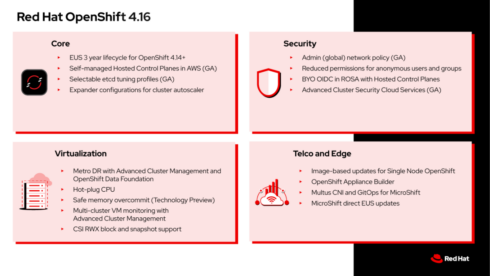
Red Hat has announced the latest version of OpenShift, its Kubernetes-based application development and deployment platform.
“Being able to more quickly modernize both infrastructure and applications are crucial capabilities to better support customer needs — but this can’t be done overnight,” said Mike Barrett, vice president and general manager of Hybrid Cloud Platforms at Red Hat. “As organizations make technology decisions in support of their AI strategies, both for today and tomorrow, they need platforms that set them up for future success while also balancing the demands of their legacy applications and environments. With Red Hat OpenShift 4.16, organizations can focus on both incremental improvements and modernization.”
This release introduces several updates to improve how companies manage virtualized workloads through OpenShift. Metro disaster recovery provides regional disaster recovery for VMs, hot-add CPU enables admins to add vCPU resources declaratively to running VMs, and multi-cluster virtualization monitoring allows admins to view all of their VMs across multiple Red Hat OpenShift clusters.
To improve the edge experience, OpenShift 4.16 introduces image-based updates for single node OpenShift. This allows customers to shift much of the update process to a pre-production environment, which cuts down on the time that needs to be spent at the production site. Updates that fail can also be rolled back to the pre-update state to quickly restore service.
The company is also previewing Appliance Builder to Red Hat partners. This new tool builds a disk image containing the Agent-based installer, which can be used to install multiple Red Hat OpenShift clusters at the edge.
OpenShift 4.16 includes Red Hat Advanced Cluster Security Cloud Service, which was previously only available in a limited capacity. This new service allows companies to secure their cloud-native workloads across different clouds and regions. It supports Red Hat OpenShift as well as third-party Kubernetes platforms like Amazon Elastic Kubernetes Service (EKS), Google Kubernetes Engine (GKE), and Microsoft Azure Kubernetes Service (AKS).
Admin Network Policy also introduces a number of new features, including policies that can’t be overridden by namespace admins or developers, cluster-wide scope, and the ability to delegate security policies to namespace admins and developers.
Other changes include an optional Extended Update Support period, self-managed hosted control planes in AWS, new ways to reduce unauthenticated user or group access, and more.
More information about Red Hat OpenShift 4.16 can be found in the company’s blog post.
You may also like…
Report: Majority of security pros admit to using “shadow SaaS” apps








